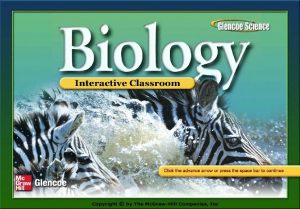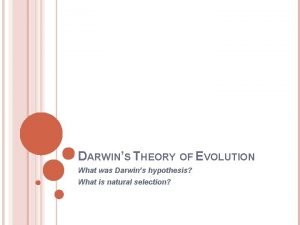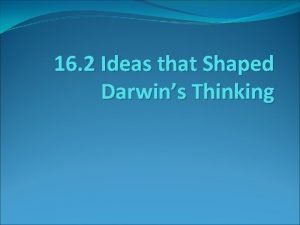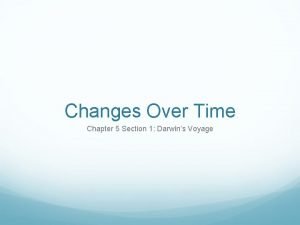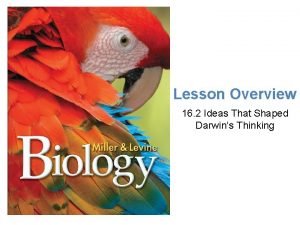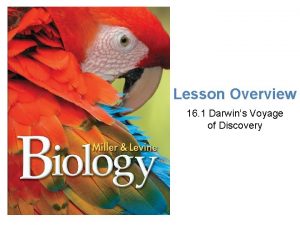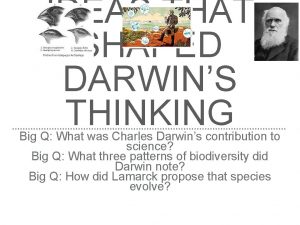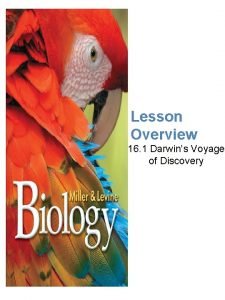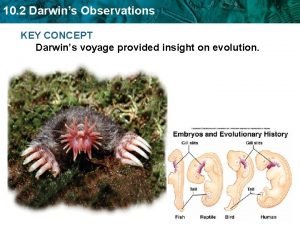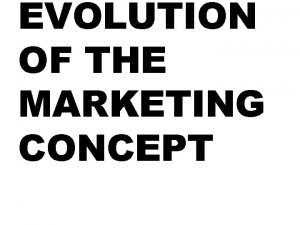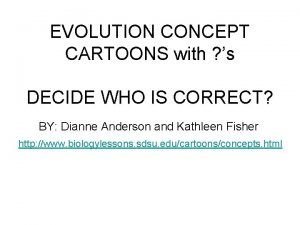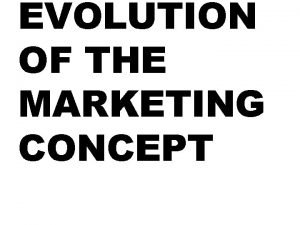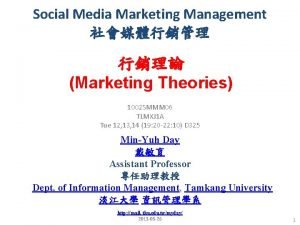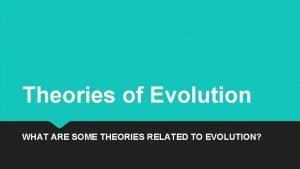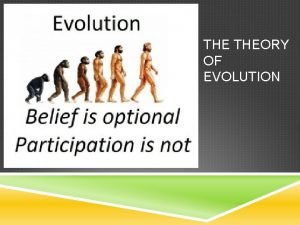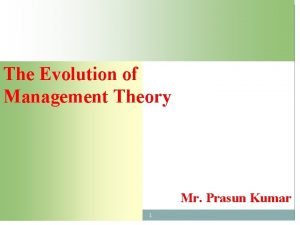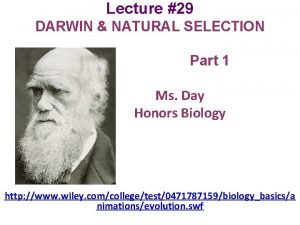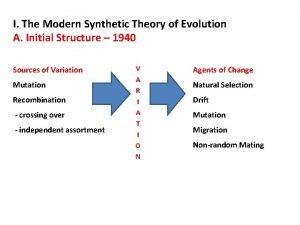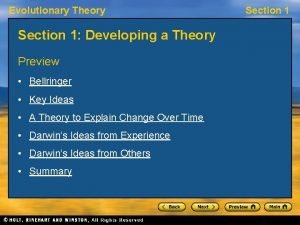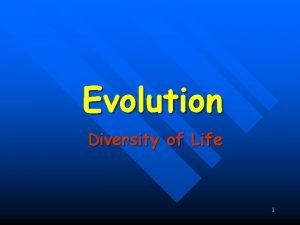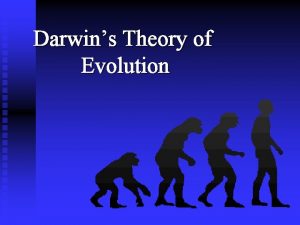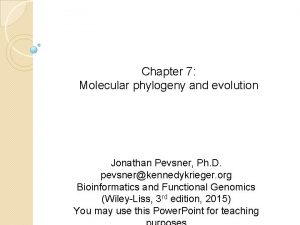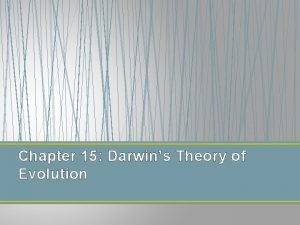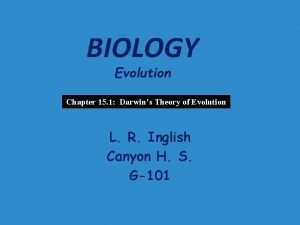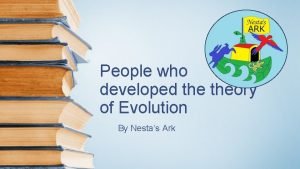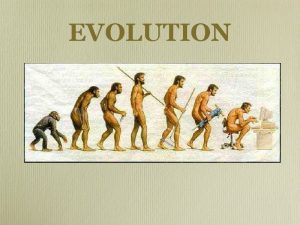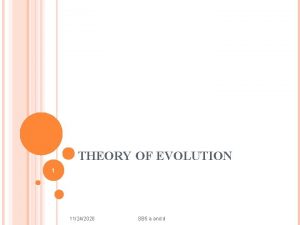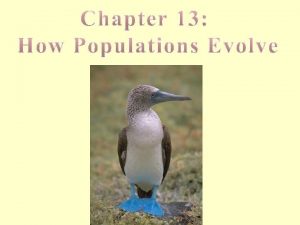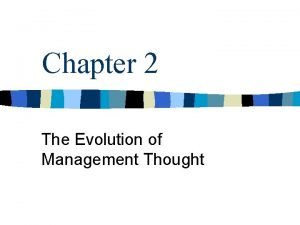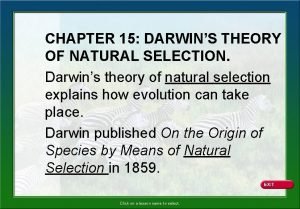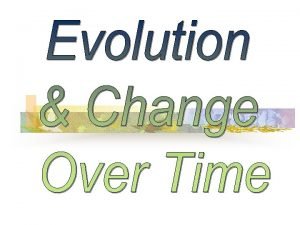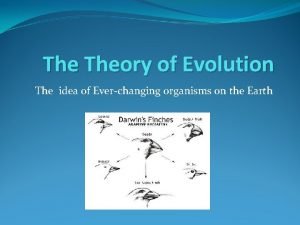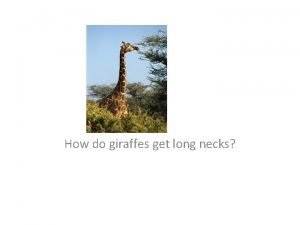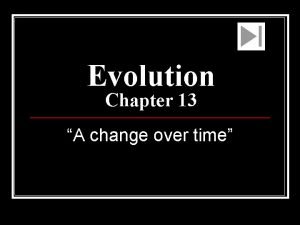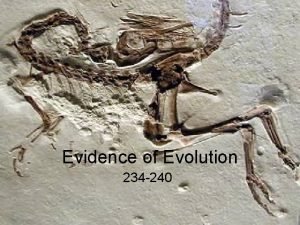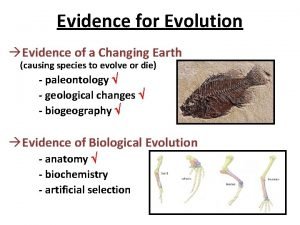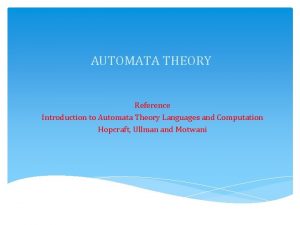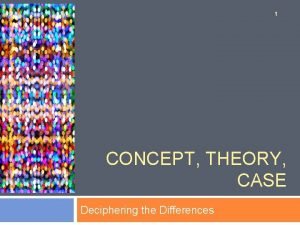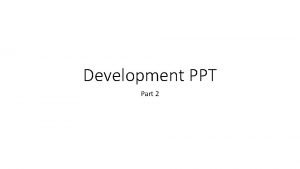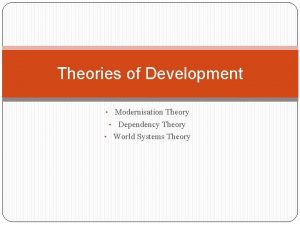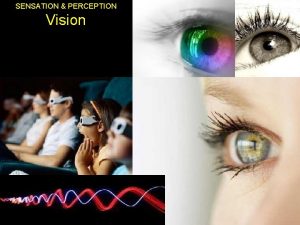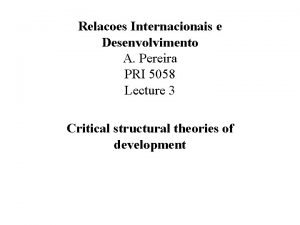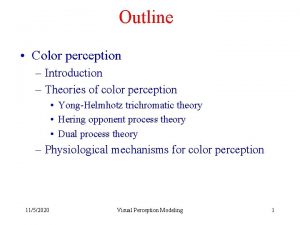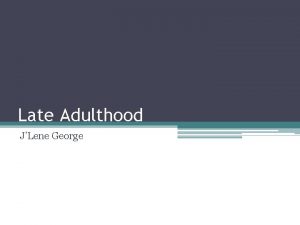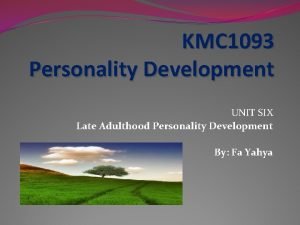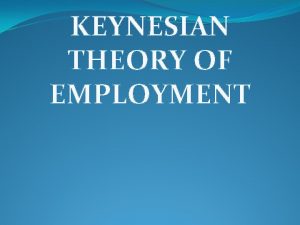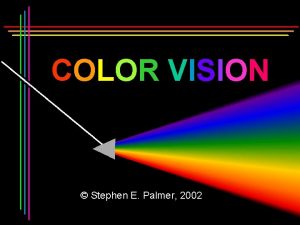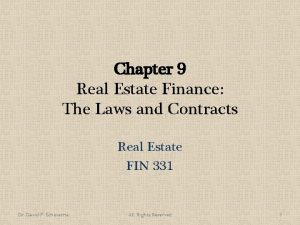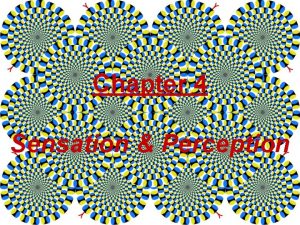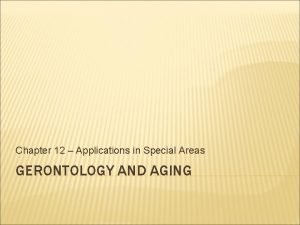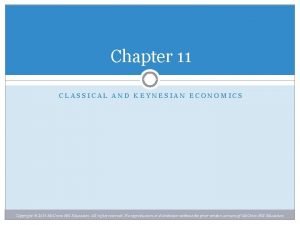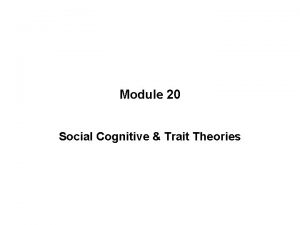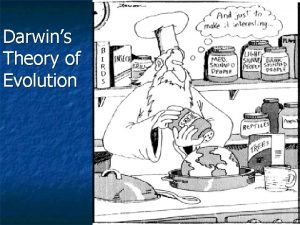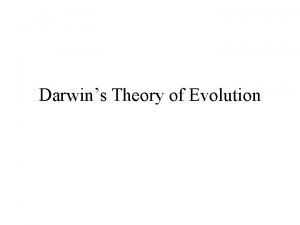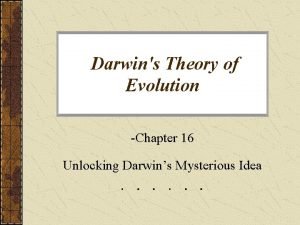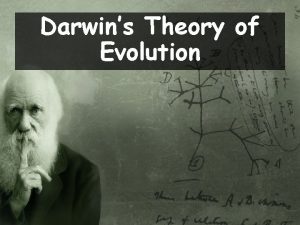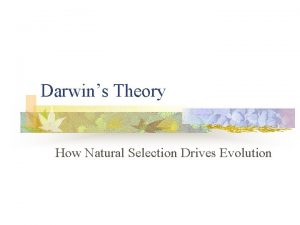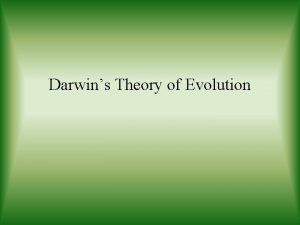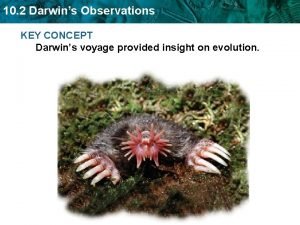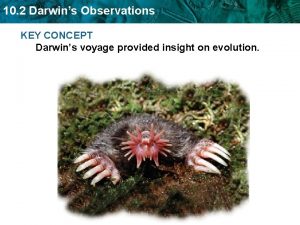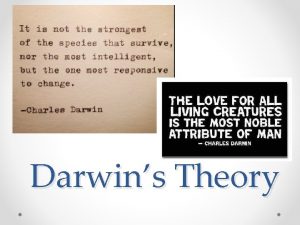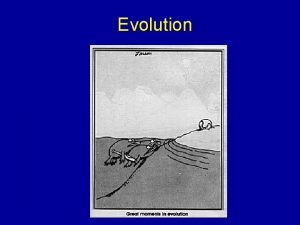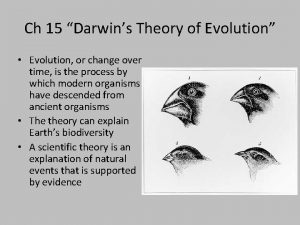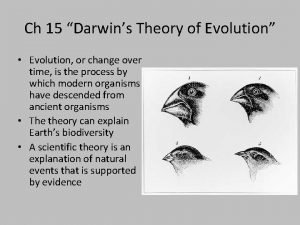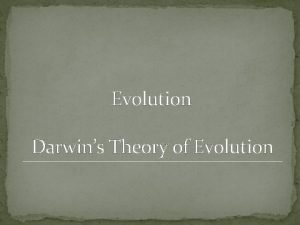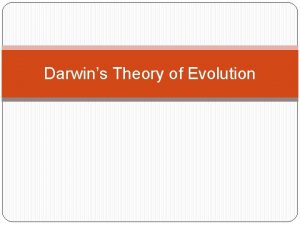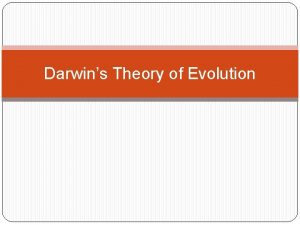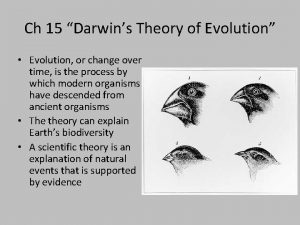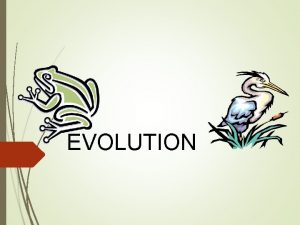Darwins Theory of Evolution Concept 14 1 pp







































































- Slides: 71

Darwin’s Theory of Evolution Concept 14. 1 pp. 292 -298

Pre-Darwin Ideas • That species are fixed, permanentunchanging. • The Earth was less than 10, 000 yrs. old and relatively unchanging. • These ideas were challenged as people became aware of diversity of plants, animals and the geological processes of Earth.

• Evolution- the biological history of life on Earth. All of the changes that have transformed life over an immense time. • Fossil Study- – Suggests Earth is much older. – Specific fossils and certain living animals were similar but not identical. Suggesting. A common ancestor – Lamark proposes life evolves or changes. – Evolution as a process of adaptation.

• Inheritance of Aquired Characteristics Lamark incorrectly thought that by using or not using certain body parts the organism developed characteristics that could be passed on to the offspring. For this to occur DNA or genes would have to be modified. • Adaptation- an inherited characteristic that improves an organism’s ability to survive and reproduce in a particular environment. • Examples of adaptations.

Darwin’s Voyage • • 1831 - HMS Beagle Darwin made observations in South America. Darwin questions his views. He notices the plants and animals of South America were distinct from species of Europe. • Species living in South America were descended from ancestral species on that continent.

Galapagos Islands. • Chain of volcanic islands off the western coast of South America. -Equador • Darwin notices - species are similar but different from the plants and animals of the nearby mainland. Each island had different species from each other. • Darwin infers - species changed and adapted to their new environments on the islands after they colonized the islands. • Charles Lyell’s - gradual and observable geological processes that explain physical features of Earth today. – Examples include erosion and earthquakes. • Conclusion- Earth is much older than previously thought.

Influences on Darwin • Malthus essay- Human suffering – human population’s growth rate is faster than the rate at which food and other resources can be supplied. • Darwin realized this concept applies to all species. • Alfred Wallace- describes the same idea of evolutionary change.

The Origin of Species • Darwin publishes his book in 1859. • 2 main points– Descent with Modification- Accounts for diversity of life • Species on organisms on Earth today descended from ancestral species. • This spread into various habitats occurred over millions of years. • In their habitats they accumulated different modifications or adaptations. • Example: fur color in rabbits.

– Natural Selection • A process, individuals with inherited characteristics that are well-suited to the environment leave more offspring than other individuals. • Over time this process can cause a change in the characteristics of a population. • Natural Selection as a cause of evolution • Adaptation is the result of evolution. • Figure 14 -9 - Example of snails. • Different from selective breeding by farmersoccurs over a shorter time and the farmers do the selection not the environment.

Evidence for Evolution Concept 14. 2 pp. 299 -304

Fossil Record • Fossils are preserved remains -past. • Most fossils -sedimentary rocks; rivers, lakes, swamps, sea. • Fossil record-chronological collection. • Each rock layer-a particular time period. • Older fossils- bottom. • Prokaryotes-oldest form of life; in rocks ~3. 5 billion yrs. old

Terms • extinct species- species that no longer exists. • Paleontologist- scientist that studies fossils. • Fossils of ancestral life link the past and the present.

Geographical Distribution • Patterns explain evolution. • Geographic distribution of organismshow species possibly evolved. • Explains why related species are found today in a particular geographical area. • Examples- Australia has many pouched mammals (marsupials) and few placental animals. • Hypothesis________________.

Homologous structures • Definition- similar structures in species that share common ancestor. • Example- forelimbs of mammals have the same skeletal parts even though the function of these limbs is completely different. – Human arm, cat foreleg, whale flipper, bat wing. – These structures have become adapted.

Vestigial Structures • Definition- remnant of a homologous structure that no longer has a function in modern related species. • Often vestigial structures -reduced size. • Example- whale vestigial hipbones. – Hypothesis- whales descended from land dwelling organisms with 4 limbs. • Natural selection favors survival of individuals with genes for reduced versions of these structures.

Comparison of Embryonic Development • Closely related organisms have similar stages of development. • All vertebrates evolved from a common ancestor. – Example- pouches on side of throat. • Fish gills • Birds and primates bones of skull.

Molecular Biology- • DNA sequences • Common genetic code shared by all species. • Unrelated individuals-more differences in DNA sequence. • If 2 species have genes and protein sequences that match closely- recent common ancestor. • If 2 species have more differences in DNA and protein sequences- no close common ancestor. • Figure 14 -16 - Humans, chimps, and gorillas based on Hemoglobin amino acid sequences are closely related.

Natural Selection Concept 14. 3 pp 305 -309

• A population- a group of individuals of the same species living in the same area at the same time. • Finches on Galapagos Islands- – Individual finches of each island make up a separate population. Over time, due to isolation they become isolated and eventually become separate species. – 13 species of finches- • key characteristic- beak- food sources.

Variation • Definition- differences among members of the same species. • This variation is inherited and passes to offspring. • Siblings share more traits with each other and their parents than they do with unrelated individuals • Individuals with inherited traits best suited to their environment survive and reproduce better than less fit individuals. • Figure 14 -19.

• Artificial Selection– Selective breeding by humans ( plants and animals) to produce offspring with desirable genetic traits. Examples– Great change in short time. • Natural Selection- comparison- the environment does the selecting • Natural Selection- pesticides – Figure 14 -21 – The pesticide does not create resistance; it selects for resistant insects already present.

Pesticide Resistance • By spraying crops with poisons to kill insect pests, humans have favored the reproduction of insects with inherited resistance to the poisons over those with no resistance.

Gene Pools Concept 14. 4 pp. 310 -316

Gene Pool • • Definition- all the alleles of a population. A population -smallest level of evolution. Reservoir of genes for natural selection. Supplies genetic variation. – Sexual recombination- meiosis and fertilization contributes to variety. – Mutations & sexual recombination -random

Frequency of alleles -how often certain alleles occur in the gene pool. This frequency is usually expressed as decimal or a percentage,

Changes in Gene Pools • Microevolution- generation to generation change in the allele frequency. • 2 main factors : – Genetic drift – Natural selection

Genetic Drift • Definition-a change in the gene pool due to chance. – The smaller the population the greater the impact of genetic drift. – Larger populations are more stable.

Reduction in Population Size • Reduces the size of gene pool ; reduces genetic variation in a population. • 2 Big effects • Bottleneck Effect- disasters – – – Earthquakes, floods, fires, droughts Drastically reduce pop. size; new population has less variation. May affect a population’s ability to adapt. Ex. - cheetah pop. • Founder Effect- a few individuals colonize a new habitat. – Galapagos Island species.

Lesser mechanisms for changing allele frequencies • 1. Gene Flow – – The exchange of genes with another population. – Migration of fertile individuals between populations. – Gene flow reduces genetic differences between populations and… could result in a single population.

• 2. Mutations – change in DNA – If carried by a gamete- enters the gene pool. – Original source of variation. – Important in asexually reproducing organisms- bacteria. • If favorable ; rapid increase due to natural selection

Natural Selection • Not random • Leads to adaptation • Biological Fitness- Contribution to the gene pool of the next generation of the most “fit”. • Production of healthy, fertile offspring is what counts.

Darwin’s Finches • Peter and Rosemary Grant’s Research • 30 yr. Study in the Galapagos. • 2 species of finches with different beak sizes. • Their data related beak size to changes in environment- wet and dry seasons and types of seeds available. • Data provided evidence for natural selection occuring in a shorter time span.

Grant’s research on Darwin’s Finches.

Evolutionary Biology 14. 5 • Natural Selection and Sickle Cell Disease. – Sickle Cell Disease- abnormal shaped rbcs- 2 alleles needed for the disease – Heterozygous- no disease but immunity to malaria. – 30% of the African population is heterozygous in endemic malaria areas. – Natural selection maintains a higher allele frequency. • Antibiotic Resistance- evolution in action – Natural selection • Resistant strains of bacteria • Huge public health issue – Resistant tuberculosis – Resistant HIV – Methicillin resistant staphylococci.

Origins of Biological Diversity Chapter 15: pp 322 -351

Concept 15. 1 The origin of new species. • Essential question: – How do biologists identify species? – How do species arise? • Objectives: – Explain biological species concept. – Compare microevolution and macroevolution. – Describe types of reproductive barriers. – Analyze how adaptive radiation contributes to species diversity.

What is a species? • A distinct form of life. • Biologists use the biological species concept to define a species as a population whose members breed with one another to produce fertile offspring. • Members of one species do not breed with members of another species. • This definition- for sexually reproducing organisms.

How does macroevolution differ from microevolution? • Microevolution is evolution on the smallest scale; generation to generation change in the allele frequencies in a population. • Macroevolution is dramatic changes that are seen in the fossil record. To explain how we evolved from simpler life forms. Includes: – Origin of different species- speciation. – Extinction of species. – Evolution of major features

Key concept- New species leads to biodiversity Figure 15 -2 Branching or cladogenic evolution. If one species evolves into two or more surviving species, diversity increases.

Reproductive Barriers: • Reproductive isolation- keeps 2 similar species from breeding. Due to: – Timing- different breeding seasons. Skunk example. – Behavior- different courtship/mating. Ex. Songs of birds – Habitat- adapted to different habitats- Fish ex. • Incompatible reproductive structures. • Infertile hybrids- Horse x Donkey mule.

Geographic Isolation separates populations leading to new species. • Examples include: – mountain ranges- range of ecological zones. – Glaciers and isolated islands • Depends on the organisms’ ability to move about. Examples: deep canyons, wide rivers. Birds, pollen, coyotes vs. antelope squirrels. • Splinter populations-separation of a small portion of the population from the main population. – Crucial event in origin of a new species. – Genetic drift- chance and Natural selection can make the splinter population less and less like the main population.

Do all isolated populations survive and become new species? • No , not all isolated populations survive and become new species. • Speciation only occurs if the two populations can no longer interbreed Not all isolated populations survive and become new species. with each other. • Figure 15. 6 model- pg 328.


Adaptive Radiation • Evolution from a common ancestor that results in diverse species adapted to different environments. • Transparency- Figure 15 -7 pg. 328. • Islands serve as showcase- ex. Hawaiian islands. – Physically diverse with differences in altitude and rainfall. – New lava flow supports adaptive radiation. – Most native species are found nowhere else.

Figure 15 -7 Adaptive radiation on an island chain may lead to several new bird species evolving from one founding population.

Tempo of Speciation • Punctuated equilibrium- a model used to address the observation that species often diverge in spurts of rapid change, then exist for long periods of time with little change. • The refining of a scientific theory of gradual change. • Natural selection and adaptation happen, but when the species is “young”. • Major changes are less common once the species is established. • Speciation is rapid in terms of the fossil record. • Most successful species last 1 -5 million years.

• • Figure 15 -9 In contrast to a more gradual model of evolution, punctuated equilibrium suggests that a new species changes most as it buds from a parent species. There is little change for the rest of the time the species exists.

Evolution is a Remodeling Process Concept 15. 2

Refining Existing Adaptations • Examples- eyes, fins, flippers, wing structures. • What are some functions of eyes in animals? • How are these useful in owls, moths, fish, rabbits, worms-planaria, humans? • Key- Natural selection/adaptations needed in different environments.

Eye types founds in different mollusks • What are mollusks? – A diverse group of soft-bodied animals that include snails, clams, mussels, oysters, octopus, squid. – Invertebrates- lack a backbone. – Characteristics- shell, muscular foot. – 50, 000 -130, 000 species- found in trees, gardens, freshwater ponds, streams, estuaries, beaches, ocean. • Occurred over several stages of development. • View On. Line Activity 15. 2 • Complex structures evolved from simpler structures.

Figure 15 -11 These diagrams show the range of complexity in the structure of eyes among various species of mollusks living today.

Adapting Existing Structures • Evolved structures fulfill different functions later on. • Chitin- exoskeleton (shell) of arthropods- segmented invertebrates with jointed legs (includes insects, spiders, lobsters, etc. ) – Earlier the chitin protected them from predators in the ocean. – Now, on land the exoskeleton protects them from dehydration. • Flippers of penguins (birds)- modified wings used now for swimming. Since penguins occupy islands where predators are rare, flight is not as important, but getting food in the water is.

Embryology • Explains genetic basis for remodeling. • Definition • Master gene controls development. • Mutations can cause some bizarre effects. Examples • Rate/timing of some developmental events Example- Feet type in salamanders.

Questions: • Does evolution always progress towards more complex organisms or adaptations? • Why or why not? • Examples?

Concept 15. 3 - Fossil Record • How Fossils Form: – Types of fossils • Geological Time Scale: – Earth’s history – 4 distinct eras (ages) – Further subdivisions – Boundaries-

• Fossil Dating: – Relative dating– Actual age- radiometric dating • Uranium-238 • Carbon dating • Continental Drift/ Plate movements: – Affects climates – Geographical isolation – Similar species in different locations – Major events • Formation of Pangaea • Breakup of Pangaea

• Mass Extinctions: – Great species loss – Examples • 65 mya. Extinction of dinosaurs–Theories • 245 mya. -90% loss of marine animals. – Affects • Negative • Positive

Taxonomy Concept 15. 4 pp. 341 -349

Taxonomy • Definition • Continuous process • Goals: – A universal scientific name for each species • Why is this necessary? – Organize species into larger groups. • Two main systems– Older Linnaean system – Modern cladistics

Evolutionary relationships among species • Phylogenetic tree– “evolutionary history” – branching pattern • Shows common ancestors • Figure 15 -25

Phylogenetic Tree In a phylogenetic tree, each branch point represents a common ancestor of the species above that point.

Classification based on homologous structures: • Homologous structure definition • Example • Evolved from single structure in a common ancestor • The more homologous structures; the more closely related the species. • Homologous- structural parts match up.

Branching pattern Figure 15 -28 Wolves and cats diverges early on Cats and leopards diverged later.

Identifying Clades • What is a clade? – An evolutionary branch in a phylogenetic tree. – Each clade consists of the ancestral species and all of its descendants. – Figure 15 -29. Identify the clades and associated species. – All organisms in a clade share homologous structures. - derived characters. • What is a cladogram? – Figure 15 -30.

Figure 15 -29 Each shaded area in the phylogenetic tree highlights one clade, such as the yellow area including species B through H.

Figure 15 -30 This cladogram shows how derived characters can be used to identify clades among certain vertebrates (animals with backbones). All the species shown here share a common ancestor that had a backbone. (Each clade is actually defined by several derived characters, not just one. )

Linnaean System of Classification • Carolus Linnaeus • Binomial Latin name – First part- genus name – Second part- species name – Example- leopard • An ordering of species into broader and broader groups. – species-genus-family-order-classphylum-kingdom – Figure 15 -24 in textbook. – Leopard example

Figure 15 -24 The leopard shares many characteristics with the lion—which belongs to the same genus—but far fewer characteristics with snails, sponges, or earthworms, though they are all members of the animal kingdom.

Convergent evolution • Definition-. – Unrelated species from similar environments have similar adaptations. – Analogous structures-. • example- wings of birds and insects. • similar adaptations. • entirely different structures. • evolved independently. • no shared common ancestor.

Molecular data to classify • • Comparing DNA/ protein sequences Research- genome Computer technology Used to backup fossil data

5 Kingdom scheme vs 3 Domain System • 5 kingdoms- Monerans-bacteria Protists Plants Fungi Animals • 3 Domains – Bacteria – Archaea – Eukaryotes
 Chapter 17 darwins theory of evolution
Chapter 17 darwins theory of evolution Chapter 15 section 1 darwins theory of natural selection
Chapter 15 section 1 darwins theory of natural selection Darwin hypothesis
Darwin hypothesis Section 15-2 ideas that shaped darwin's thinking
Section 15-2 ideas that shaped darwin's thinking 15-2 ideas that shaped darwin's thinking
15-2 ideas that shaped darwin's thinking Adaptation
Adaptation Ideas that shaped darwin's thinking
Ideas that shaped darwin's thinking Species vary locally
Species vary locally Ideas that shaped darwin's thinking answer key
Ideas that shaped darwin's thinking answer key Darwin's voyage of discovery
Darwin's voyage of discovery Darwins observations
Darwins observations Evolution of marketing concept
Evolution of marketing concept Evolution concept cartoon
Evolution concept cartoon Marketing concept evolution
Marketing concept evolution Evolution of marketing concept
Evolution of marketing concept Lamarck's theory of evolution
Lamarck's theory of evolution Developmental homologies
Developmental homologies Evolution of management theory
Evolution of management theory 3 types of natural selection
3 types of natural selection Synthetic theory
Synthetic theory Modern evolution theory
Modern evolution theory Lamarck’s theory of evolution.
Lamarck’s theory of evolution. What was lamarck's theory of evolution
What was lamarck's theory of evolution Strengths and weaknesses of evolutionary theory page 386
Strengths and weaknesses of evolutionary theory page 386 Neutral theory of molecular evolution notes
Neutral theory of molecular evolution notes Section 3 other mechanisms of evolution
Section 3 other mechanisms of evolution Chapter 15 darwin's theory of evolution section review 15-1
Chapter 15 darwin's theory of evolution section review 15-1 Homologous structures definition biology
Homologous structures definition biology Charles darwin theory of evolution
Charles darwin theory of evolution Theory of natural selection
Theory of natural selection Lamarck theory of evolution notes
Lamarck theory of evolution notes Theory of evolution
Theory of evolution Theory of evolution
Theory of evolution Evolution of management thoughts
Evolution of management thoughts Natural selection
Natural selection Homologous structures examples
Homologous structures examples Geographic isolation
Geographic isolation Lamarck theory of evolution notes
Lamarck theory of evolution notes Endosymbiont theory
Endosymbiont theory Convergent evolution
Convergent evolution The theory that evolution occurs slowly but steadily
The theory that evolution occurs slowly but steadily Biochemical evidence examples
Biochemical evidence examples The theory that evolution occurs slowly but steadily
The theory that evolution occurs slowly but steadily Explain the ideal self
Explain the ideal self Pengertian pemasaran
Pengertian pemasaran Central concepts of automata theory
Central concepts of automata theory Theory vs concept
Theory vs concept Models of community development ppt
Models of community development ppt Theory x and theory y
Theory x and theory y Compare continental drift and plate tectonics
Compare continental drift and plate tectonics Dependency theory
Dependency theory Sensation
Sensation Criticism of dependency theory
Criticism of dependency theory Plate tectonic theory vs continental drift
Plate tectonic theory vs continental drift Theory of color vision
Theory of color vision Neoclassical organization theory
Neoclassical organization theory Theory x and theory y of motivation
Theory x and theory y of motivation Hawthorne effect in business
Hawthorne effect in business Integrity vs despair
Integrity vs despair Conclusion of adulthood
Conclusion of adulthood Classical theory vs keynesian theory
Classical theory vs keynesian theory Stephen e palmer
Stephen e palmer Theoretical plates
Theoretical plates Lien vs title theory
Lien vs title theory Binocular cues
Binocular cues Lien theory vs title theory
Lien theory vs title theory Continuity theory vs activity theory
Continuity theory vs activity theory Classical theory vs keynesian theory
Classical theory vs keynesian theory Y and y management
Y and y management Social cognitive personality
Social cognitive personality Neoclassical growth theory vs. endogenous growth theory
Neoclassical growth theory vs. endogenous growth theory Game theory and graph theory
Game theory and graph theory

